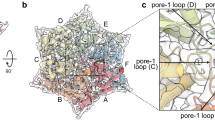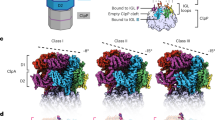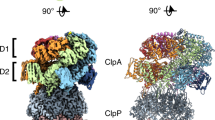Abstract
The N-end rule states that the half-life of a protein is determined by the nature of its amino-terminal residue1. Eukaryotes and prokaryotes use N-terminal destabilizing residues as a signal to target proteins for degradation by the N-end rule pathway. In eukaryotes an E3 ligase, N-recognin, recognizes N-end rule substrates and mediates their ubiquitination and degradation by the proteasome1,2. In Escherichia coli, N-end rule substrates are degraded by the AAA + chaperone ClpA in complex with the ClpP peptidase (ClpAP)3. Little is known of the molecular mechanism by which N-end rule substrates are initially selected for proteolysis. Here we report that the ClpAP-specific adaptor, ClpS, is essential for degradation of N-end rule substrates by ClpAP in bacteria. ClpS binds directly to N-terminal destabilizing residues through its substrate-binding site distal to the ClpS–ClpA interface4, and targets these substrates to ClpAP for degradation. Degradation by the N-end rule pathway is more complex than anticipated and several other features are involved, including a net positive charge near the N terminus and an unstructured region between the N-terminal signal and the folded protein substrate. Through interaction with this signal, ClpS converts the ClpAP machine into a protease with exquisitely defined specificity, ideally suited to regulatory proteolysis.
This is a preview of subscription content, access via your institution
Access options
Subscribe to this journal
Receive 51 print issues and online access
$199.00 per year
only $3.90 per issue
Buy this article
- Purchase on Springer Link
- Instant access to full article PDF
Prices may be subject to local taxes which are calculated during checkout




Similar content being viewed by others
References
Varshavsky, A. The N-end rule: functions, mysteries, uses. Proc. Natl Acad. Sci. USA 93, 12142–12149 (1996)
Varshavsky, A. The N-end rule and regulation of apoptosis. Nature Cell Biol. 5, 373–376 (2003)
Tobias, J. W., Shrader, T. E., Rocap, G. & Varshavsky, A. The N-end rule in bacteria. Science 254, 1374–1377 (1991)
Zeth, K. et al. Structural analysis of the adaptor protein ClpS in complex with the N-terminal domain of ClpA. Nature Struct. Biol. 9, 906–911 (2002)
Baker, R. T. & Varshavsky, A. Inhibition of the N-end rule pathway in living cells. Proc. Natl Acad. Sci. USA 88, 1090–1094 (1991)
Dougan, D. A., Reid, B. G., Horwich, A. L. & Bukau, B. ClpS, a substrate modulator of the ClpAP machine. Mol. Cell 9, 673–683 (2002)
Lupas, A. N. & Koretke, K. K. Bioinformatic analysis of ClpS, a protein module involved in prokaryotic and eukaryotic protein degradation. J. Struct. Biol. 141, 77–83 (2003)
Knoblauch, N. T. et al. Substrate specificity of the SecB chaperone. J. Biol. Chem. 274, 34219–34225 (1999)
Deuerling, E. et al. Trigger factor and DnaK possess overlapping substrate pools and binding specificities. Mol. Microbiol. 47, 1317–1328 (2003)
Rudiger, S., Germeroth, L., Schneider-Mergener, J. & Bukau, B. Substrate specificity of the DnaK chaperone determined by screening cellulose-bound peptide libraries. EMBO J. 16, 1501–1507 (1997)
Levy, F., Johnston, J. A. & Varshavsky, A. Analysis of a conditional degradation signal in yeast and mammalian cells. Eur. J. Biochem. 259, 244–252 (1999)
Bradshaw, R. A., Brickey, W. W. & Walker, K. W. N-terminal processing: the methionine aminopeptidase and Nα-acetyl transferase families. Trends Biochem. Sci. 23, 263–267 (1998)
Hershko, A., Heller, H., Eytan, E., Kaklij, G. & Rose, I. A. Role of the α-amino group of protein in ubiquitin-mediated protein breakdown. Proc. Natl Acad. Sci. USA 81, 7021–7025 (1984)
Mayer, A., Siegel, N. R., Schwartz, A. L. & Ciechanover, A. Degradation of proteins with acetylated amino termini by the ubiquitin system. Science 244, 1480–1483 (1989)
Ben-Bassat, A. et al. Processing of the initiation methionine from proteins: properties of the Escherichia coli methionine aminopeptidase and its gene structure. J. Bacteriol. 169, 751–757 (1987)
Ditzel, M. et al. Degradation of DIAP1 by the N-end rule pathway is essential for regulating apoptosis. Nature Cell Biol. 5, 467–473 (2003)
Rao, H., Uhlmann, F., Nasmyth, K. & Varshavsky, A. Degradation of a cohesin subunit by the N-end rule pathway is essential for chromosome stability. Nature 410, 955–959 (2001)
Datsenko, K. A. & Wanner, B. L. One-step inactivation of chromosomal genes in Escherichia coli K-12 using PCR products. Proc. Natl Acad. Sci. USA 97, 6640–6645 (2000)
Kramer, A. & Schneider-Mergener, J. Synthesis and screening of peptide libraries on continuous cellulose membrane supports. Methods Mol. Biol. 87, 25–39 (1998)
Acknowledgements
We thank R. J. Dohmen for pUB23-M, pUB23-R, pUB23-L and pJT184; R. Volkmer for synthesis of peptide libraries; J. M. Weber for technical assistance; R. Nicolay for help with surface plasmon resonance; and laboratory members of the Clp group for discussions. This work was supported by the Deutsche Forschungsgemeinschaft priority program, proteolysis in prokaryotes: protein quality control and regulatory principles, the Fonds der Chemischen Industrie and the Australian Research Council QEII Fellowship to D.A.D.
Author information
Authors and Affiliations
Corresponding author
Ethics declarations
Competing interests
Reprints and permissions information is available at npg.nature.com/reprintsandpermissions. The authors declare no competing financial interests.
Supplementary information
Supplementary Notes
This file contains Supplementary Figure Legends and Supplementary Methods (PDF 127 kb)
Supplementary Figure 1
N-end rule degradation pathway in prokaryotes and eukaryotes (PDF 629 kb)
Supplementary Figure 2
ClpS binds to N-End rule peptides on C-terminal immobilised peptide library (PDF 46 kb)
Supplementary Figure 3
ClpS inhibits the slow degradation of wt-Linker-GFP (PDF 16 kb)
Supplementary Figure 4
ClpS binds FR-GFP and FR-Linker-GFP (PDF 17 kb)
Supplementary Figure 5
Mutations in the binding side for N-end rule substrates of ClpS do not effect the interaction of ClpS wit ClpA (PDF 731 kb)
Rights and permissions
About this article
Cite this article
Erbse, A., Schmidt, R., Bornemann, T. et al. ClpS is an essential component of the N-end rule pathway in Escherichia coli. Nature 439, 753–756 (2006). https://doi.org/10.1038/nature04412
Received:
Accepted:
Issue Date:
DOI: https://doi.org/10.1038/nature04412
This article is cited by
-
Membrane Proteins as a Regulator for Antibiotic Persistence in Gram-Negative Bacteria
Journal of Microbiology (2023)
-
Single-molecule fluorescence methods for protein biomarker analysis
Analytical and Bioanalytical Chemistry (2023)
-
Expression and function of clpS and clpA in Xanthomonas campestris pv. campestris
Antonie van Leeuwenhoek (2022)
-
Protein degradation control and regulation of bacterial survival and pathogenicity: the role of protein degradation systems in bacteria
Molecular Biology Reports (2021)
-
Polymerase delta-interacting protein 38 (PDIP38) modulates the stability and activity of the mitochondrial AAA+ protease CLPXP
Communications Biology (2020)
Comments
By submitting a comment you agree to abide by our Terms and Community Guidelines. If you find something abusive or that does not comply with our terms or guidelines please flag it as inappropriate.



